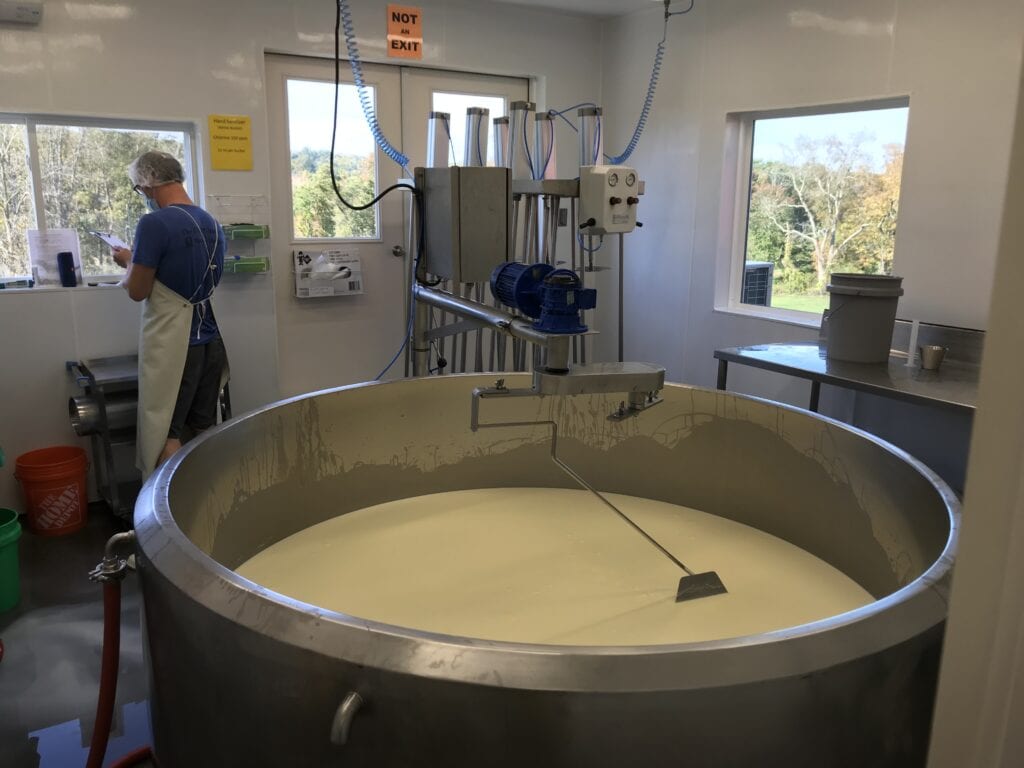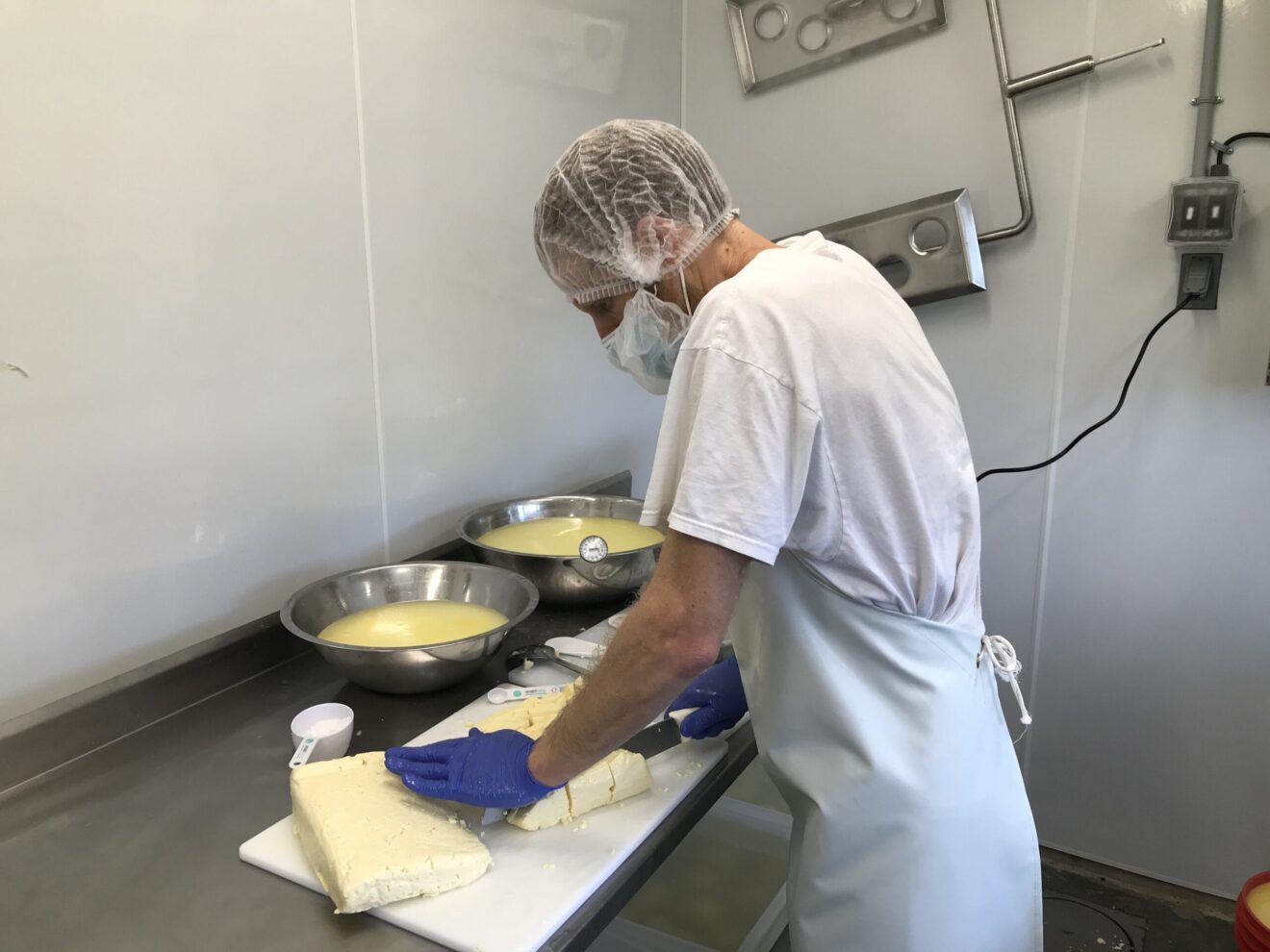COLCHESTER — Clad in white rubber boots and a white hairnet and mask, cheesemaker Mark Gillman picked up a scrub brush from a bucket of sudsy water and scoured the front of his white apron.
“Cheesemaking has been called a glorified cleaning job. You spend a lot of time cleaning equipment and also cleaning yourself,” he laughed as he scanned rectangles of milk curds stacked on a nearby stainless steel table, ready to be transformed into mozzarella via a process of heating and stretching called “pasta filata,” sometimes called “spun paste” or stretched curd.
Gillman, who runs Cato Corner Farm with his mother, Elizabeth MacAlister, makes his mozzarella the traditional way — by hand, with cultures rather than acid to lower the pH.
In the smallish room, with large windows and white walls, he had set up stainless steel bowls of hot water, each one hotter than the next, to warm the curds. The process softens the structure of the curd so that it can be stretched.
“I’m slowly warming the curd, I want to get it up to about 140 or 150 degrees, gradually,” he said. After cutting the curds into chunks, he sunk a handful into the coolest water and let them sit for a minute. Then he moved them to the next bowl and repeated the process. When the curds arrived in the hottest water bowl, Gillman began to work the slippery blob with two spatulas, stretching the cheese vertically a number of times before he broke off smaller pieces and worked them into round shapes that he placed into vats filled with cold water on a lower shelf.
“I work it fairly quickly. I want to get that nice stretchy consistency. The cheese should be stretched throughout the mass, there shouldn’t be any lumpy parts,” he said.
Mozzarella, a soft fresh cheese, is a new venture for Gillman and the farm, which is known nationally for the quality of its aged cheeses. To be sold in the United States, cheeses aged for less 60 days, like mozzarella, must be made with pasteurized milk, requiring large vats and machines — and the space to house them.

In the middle of the room where Gillman worked stood a huge rectangular pasteurizer, known as a “fat pasteurizer, that heats up milk to about 150 degrees for at least ½ hour to meet safety standards.
“One thing I’m learning is that pasteurized cheese takes longer because it takes time to heat that milk up and pasteurize it and cool it back down. You have to factor that into our day for sure,” he said.
In the next room was the farm’s new raw milk processor — a gigantic stainless steel vat with a mechanical arm attached that was stirring that day’s milk with a spatula-like tool.
“This is all new equipment back here. We just started using this room in April — it’s all new construction,” he said.
Gillman said there’s a fairly steep learning curve in learning how to make fresh cheese, but the process offers more opportunities to make changes very quickly than with aged cheese.
“We consulted with people who have done this cheese for years and we’ve watched a bunch of videos. We can watch people making traditional fior di latte mozzarella,” he said. “The texture is the main thing we’ve been struggling with, just making sure we get that right. Also the flavor should be good and I feel like we got to that more quickly because we have very nice milk.”
Gillman’s family bought the 75-acre farm in 1979. His mother became licensed to make and sell aged cheese in 1997 and began the venture with 13 cows. Gillman joined the cheesemaking operation and got his license in 1999. The pair worked together in a small building until a few years ago when they added on nearly 3,000 square feet. In a series of connected rooms, the new construction holds a variety of new equipment as well as a walk-in cooler.
He said his mother chose cheese instead of other value-added dairy products, like ice cream, because it was part of the family tradition.
“In the 1900s, when I was first in college and then living in Washington, D.C., for a while, we’d bring home fancy cheeses for the holidays. There weren’t fancy cheese shops back then. There was Dean & DeLuca in New York and Georgetown, so I’d go there and bring home all these fancy cheeses, mostly European and a few American ones and that was our upbringing,” he said. “She grew up in East Providence and her father used to love to go to the Italian cheese shops there … It was part of her upbringing and she had made some cheese at home just for us and she had ideas not only about how to do it but what the cheese should taste like.”
Gillman said he and MacAlister were also looking for a way to diversify their product line with something that would have shorter turnaround,
“The idea was to be able to grow our business and expand the customer base,” he said. “The challenge with aged cheese is we have it in inventory for a long time and it requires a specific environment — it’s not just a simple walk in cooler, it’s creating a micro climate in there. Right now our case is full, we don’t have any more space.”
Part of the original goal was to buy milk from other farms to grow the business without having to produce more milk on site and to support other Connecticut dairies, but COVID has temporarily halted that plan.
“Obviously that’s a good way for us to support Connecticut dairy farmers too,” he said. “The price of fluid milk is never quite enough. It varies tremendously and it’s never quite enough to cover the expenses of producing milk in the Northeast.”
Cato Corner has about 39 milking cows and a total of almost 80 cows, counting calves, heifers and pregnant cows.
“We have roughly the same number of animals year round, but the summer milk is definitely different. The cows are out in the pasture, so it’s actually a little bit lower in milk solids, but it’s got a nice kind of grassy flavor,” he said.
Farmers markets — and sales at the farm — have provided direct contact with customers and quick feedback, which is invaluable, Gillman said
“It’s very hands-on, that’s one of the things I love about cheesemaking in general, especially because you do get instant feedback on how it’s come out,” he said. “That’s a change for us, obviously, because we’re making aged cheese and it’s months before we know how it’s come out. With this cheese we can taste it in 10 minutes.”

